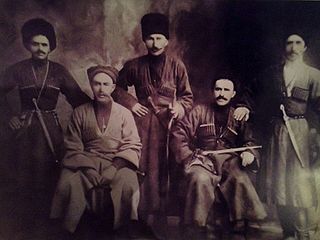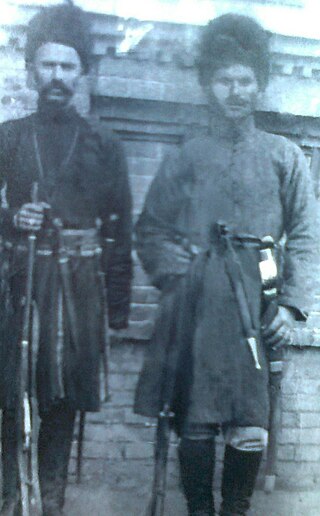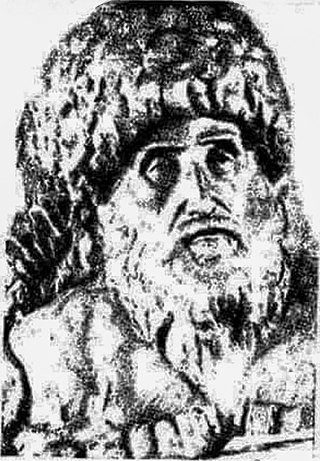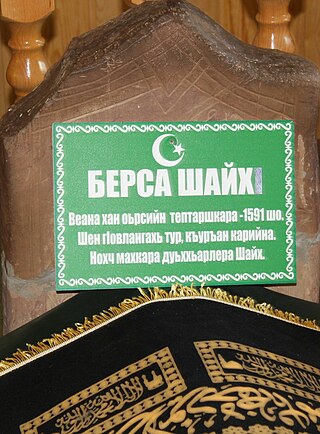Related Research Articles

Kumyks are a Turkic ethnic group living in Dagestan, Chechnya and North Ossetia. They are the largest Turkic people in the North Caucasus.

The Chechens, historically also known as Kisti and Durdzuks, are a Northeast Caucasian ethnic group of the Nakh peoples native to the North Caucasus. They are the largest ethnic group in the region and refer to themselves as Nokhchiy. The vast majority of Chechens are Muslims and live in Chechnya, an autonomous republic within the Russian Federation.
Tukkhum is a term and system introduced in the 1960s, most notably by Soviet Chechen writer Magomet Mamakaev in 1962. This system does not properly apply to the Chechen nation and the social structure of Chechen clans.
Yalkharoy is a rural locality in Urus-Martanovsky District of the Republic of Chechnya, Russia.

Vedeno is a rural locality and the administrative center of Vedensky District, Chechnya.

The Nakh peoples are a group of North Caucasian peoples identified by their use of the Nakh languages and other cultural similarities. These are chiefly the ethnic Chechen, Ingush and Bats peoples of the North Caucasus, including closely related minor or historical groups.

The Orstkhoy, historically commonly known under their exonyms: Karabulaks, Balsu, Baloy, are a historical ethnoterritorial society among the Chechen and Ingush peoples. Their homeland is in the upper reaches of the Assa and Fortanga rivers in the historical region of Orstkhoy-Mokhk. In the tradition of the Chechen ethno-hierarchy, it is considered one of the nine historical Chechen tukkhums, in the Ingush tradition as one of the seven historical Ingush shahars.

The Chechen–Russian conflict was the centuries-long ethnic and political conflict, often armed, between the Russian, Soviet and Imperial Russian governments and various Chechen forces. The recent phase of the conflict started after the dissolution of the Soviet Union in 1991 and ended with the oppression of Chechen separatist leaders and crushing of the separatist movement in the republic proper in 2017.
Kumykia, or rarely called Kumykistan, is a historical and geographical region located along the Caspian Sea shores, on the Kumyk plateau, in the foothills of Dagestan and along the river Terek. The term Kumykia encompasses territories which are historically and currently populated by the Turkic-speaking Kumyk people. Kumykia was the main "granary of Dagestan". The important trade routes, such as one of the branches of the Great Silk Road, passed via Kumykia.
Cheberloyevsky District, is a district (raion) of Chechnya. The district was recreated in 2012. However, the official restoration process of the district is not complete. The district also existed between 1926 and 1944. The administrative center is the village of Sharo-Argun.

Zandkhoy, Zandakhoy is a Chechen teip (clan) from the historic region of Ichkeria and belongs to the tukkhum Nokhchmakhkakhoy, also called Ichkerians. The centre of the teip is the village Zandak, which is located in the Nozhay-Yurtovsky District.
The Battle of Khachara was a confrontation between Chechens and the Avar Khanate led by Mohammad Khan. The battle took place in the Khachara gorge in the Avar Khanate during the 17th century.

Uma Duyev was a Chechen military leader, mudir and naib of Imam Shamil. He later was naib of Kiyalala and other nearby Dagestani villages, as well as Zumsoy, a representative of the Zumsoy clan, and a participant in the Caucasian War of 1817–1864 as a naib and commander. He was a leader in the uprisings in Chechnya in 1860–1861 and 1877 and Chechen national hero.
The Chechen–Kazikumukh war, also known as Chechen reconquista or Z'okk-K'ant's campaign against the Kazikumukhs, was a war between Chechens and the Laks of Gazikumukh Shamkhalate, the Kabardians and the Kalmyks in the 16th century. The war began as a result of Chechens from Nashkh region resettling around the Kazikumukh controlled area of T'sontaroy and refusing to pay tribute to the Kazikumukhs. The war lasted 10 years, defeating the Kazikumukh in 3 years, and conflict with the Kalmyks and Karbardians continued for 6 more years, both ending with the Chechens reconquering former lands of Aukh and Nokhchmokhk stretching to the shoreline of the Caspian Sea, and pushing the Kalmyks beyond the Terek river. The Kazikumukh, worrying that the Chechens will continue to conquer more lands, sent a messenger to Sulak in order to reach an agreement with the Chechens. As a result the Chir-Yurt peace treaty was signed and one of the Shamkals sons was offered to the Chechens as an amanat (hostage).

Galashians, were a historical Ingush ethnoterritorial society, which formed in the middle of the 18th century. The name comes from the village of Galashki, which is geographically located in the very center of the society. Galashians were located in the middle and lower reaches of the river Assa and the basin of the river Fortanga.

Meredzhi is a non-residential rural locality in Galanchozhsky District of the Republic of Chechnya, Russia.

Aidemir Bardykhanov, also known as Aidemir Turlov was a prince from the Turlov dynasty and the Senior Prince of the Chechen principality from 1732 to his death in 1746 and was also a Khan of the Endirey Khanate. He is famous for his role in the Battle of Chechen–Aul, where he led Chechen rebels into victory against Russian troops.
Khasbulat Bamatov, Kazbulat Bammatov or Khasbulat Turlov, was a prince from the Turlov dynasty and the Senior Prince of the Chechen Principality from 1728 to his death during the Battle of Chechen–Aul on July 7, 1732. He was succeeded by his rival, Aidemir Bardykhanov. Khasbulat was known for his pro–Russian administration, unlike his predecessors and successor.

Bersa-Sheikh was a Chechen sheikh and one of the first Islamic preachers in Chechnya who played a major role in the Islamisation of the Chechens of Nakhch-Mokhk (Ichkeria). Bersa-Sheikh was a friend and associate of Termaol Shaykh, one of the preachers of Islam in Chechnya around 1607.

Tumsoy-Lam mountain, also known as Alpiyskoye, is a mountain peak located in the Argun Gorge on the border of the Shatoysky and Itum-Kalinsky districts of the Chechen Republic. It is situated in the eastern part of the Greater Caucasus, between the Martan and Argun rivers, with the elevation of 2072 metres, according to other sources - 2074 metres, 1855 metres. The mountain extends for 10 versts to the west-northwest. Tumsoy-Lam is the ancestral mountain of the Chechen Tumsoy Teip.
References
- ↑ Матиев 2002, p. 324.
- ↑ Шаповалов & Кемпинский 2001, p. 190.
- 1 2 3 Тесаев 2019.
- ↑ Tesaev, Z. A. (Zelimkhan Adamovich) (2019). Institut "Mekhk-Daĭ" : v istorii Chechni (XVI - 1 -i︠a︡ tretʹ XIX v.). Groznyĭ. p. 319. ISBN 978-5-4314-0386-6. OCLC 1141866514.
{{cite book}}: CS1 maint: location missing publisher (link) - ↑ Matsiev 1965, p. 5.
- ↑ Tesaev, Z.A. (Zelimkhan Adamovich) (2019). Institut "Mekhk-Daĭ" : v istorii Chechni (XVI - 1 -i︠a︡ tretʹ XIX v.). Groznyĭ. p. 322. ISBN 978-5-4314-0386-6. OCLC 1141866514.
{{cite book}}: CS1 maint: location missing publisher (link) - ↑ Tesaev, Z.A. (Zelimkhan Adamovich) (2019). Institut "Mekhk-Daĭ" : v istorii Chechni (XVI - 1 -i︠a︡ tretʹ XIX v.). Groznyĭ. pp. 322–323. ISBN 978-5-4314-0386-6. OCLC 1141866514.
{{cite book}}: CS1 maint: location missing publisher (link) - ↑ Ахмадов (2009). ОЧЕРК исторической географии и этнополитического развития Чечни в XVI 9 XVIII веках. pp. 135–136.
- ↑ "Правители Ункратля и Киялала. История (Исмаил Газимагомедов 2) / Проза.ру".
- ↑ Айтберов 2006, pp. 68–70.
- ↑ "РУССКО-ЧЕЧЕНСКИЕ ОТНОШЕНИЯ ВТОРАЯ ПОЛОВИНА XVI-XVII в. DrevLit.Ru - библиотека древних рукописей". drevlit.ru. Retrieved 2020-07-06.
- ↑ "1665 г. не ранее сентября 25. — Челобитная грузинского царевича Николая Давидовича царю Алексею Михайловичу с рассказом о трудностях пути из Тушинской земли в Терский город через Теремскую, Чантинскую, Чинахскую и Шибутскую земли и владение аварского мурзы Загоштоки". www.vostlit.info. Retrieved 2020-07-06.
- ↑ "Т. М. Айтберов Ш. М. Хапизов ЭПИГРАФИЧЕСКИЕ ИСТОЧНИКИ ПО ИСТОРИИ РАСПРОСТРАНЕНИЯ ИСЛАМА В ЧЕЧНЕ(XVI‑XIX вв)". www.izvestia-soigsi.ru. Retrieved 2020-07-06.